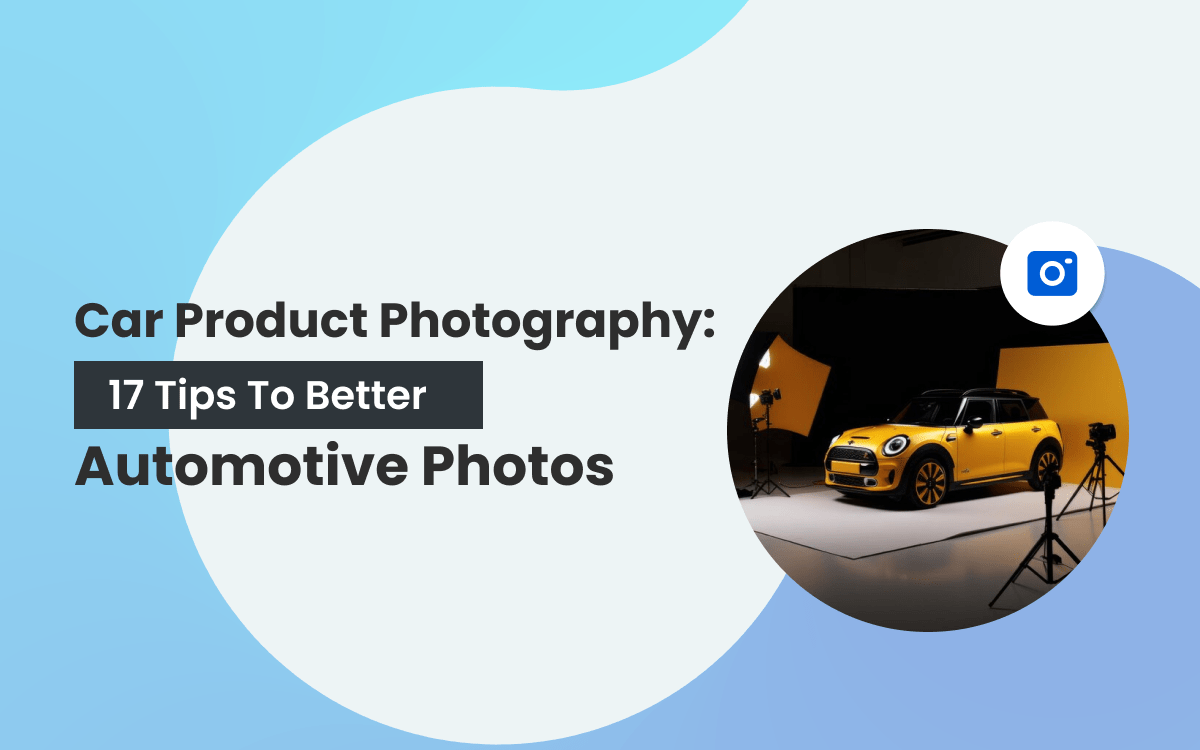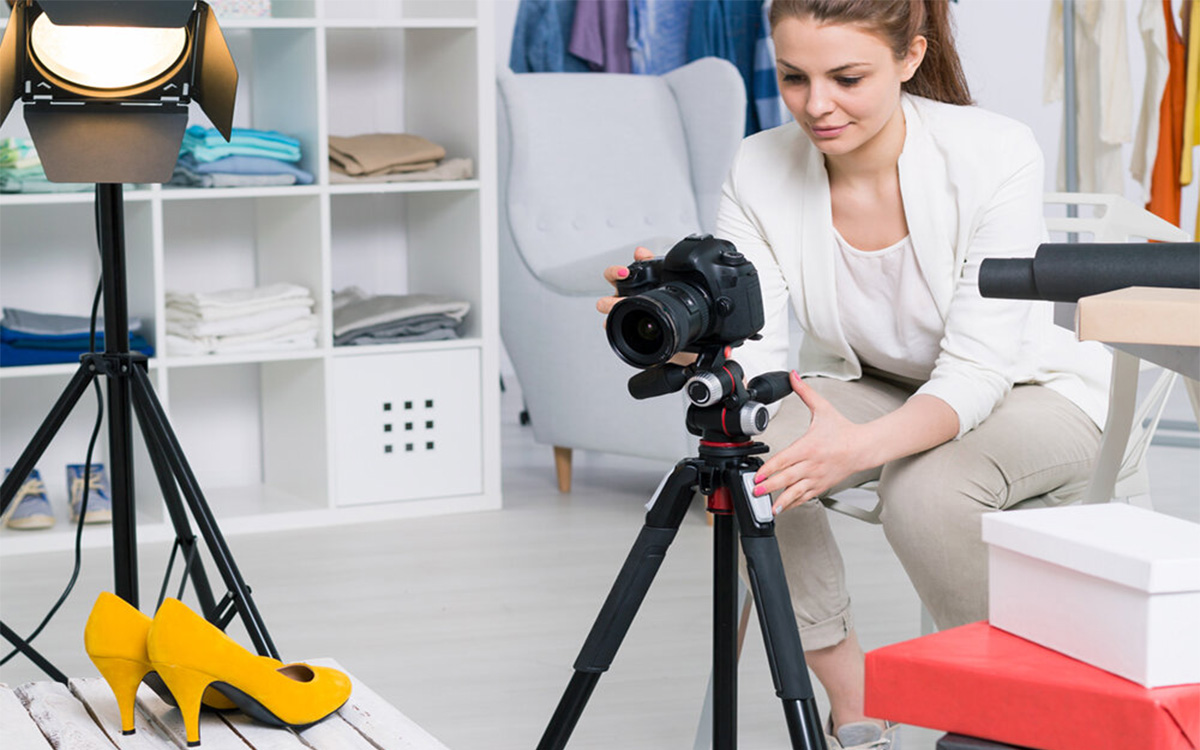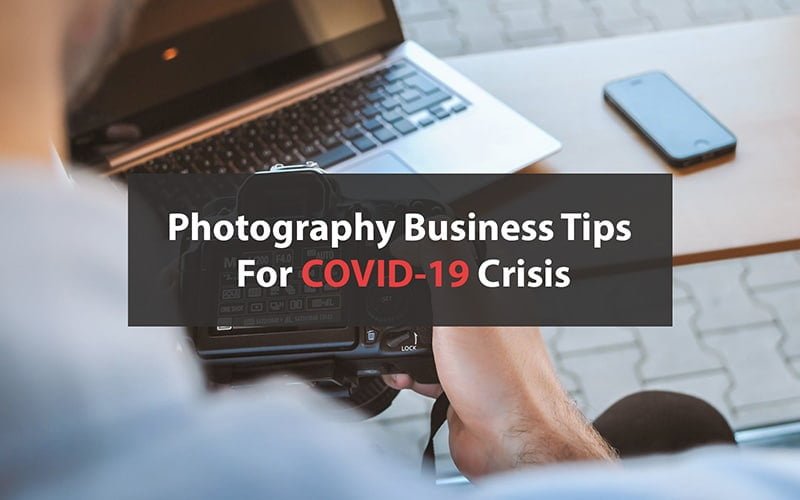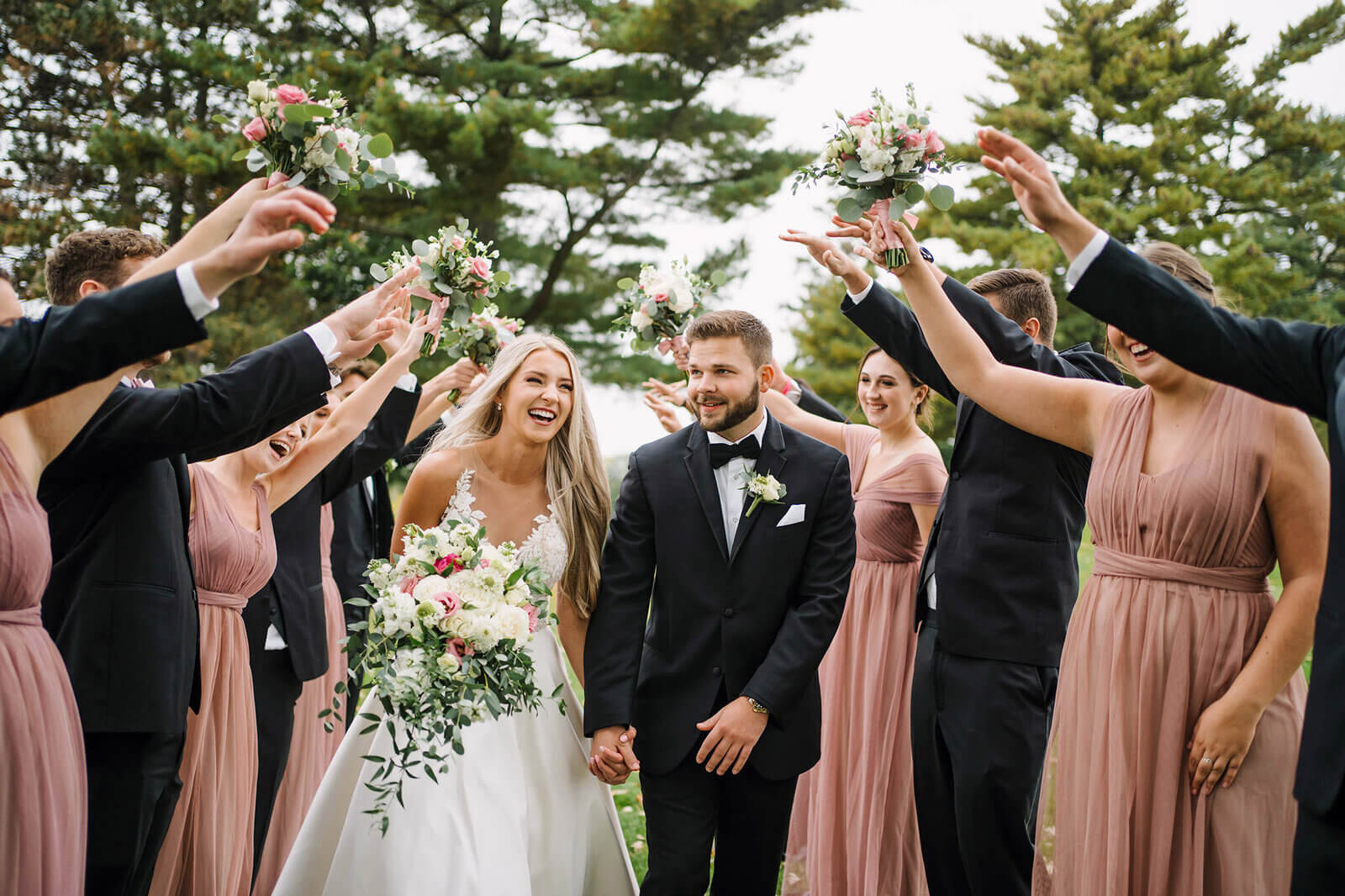Car product photography is one of the most demandable e-commerce photography niches. With an international market size of $3564.67 billion in 2023, as the industry is skyrocketing, so is the need for superior images.
But the car product is gigantic, and taking the shot is challenging. Suppose you are going to add this skill to your portfolio. You are at the right place.
Keep reading on to learn these tips that will help hone your skill and photoshoot the big-sized, sleek, designed, reflective subject at its best.
Let’s get started.
What you’ll learn in this article
- 1 What is Car Product Photography?
- 2 What are the Different Types of Car Photography?
- 2.1 1. Commercial Car Photography
- 2.2 2. Drone or Aerial Car Photography
- 2.3 3. Lifestyle Car Photography
- 2.4 4. Concept Car Photography
- 2.5 5. Vintage Car Photography
- 2.6 6. Sports Car Photography
- 2.7 7. Car Event Photography
- 2.8 8. Studio Car Photography
- 2.9 9. Car Photography in Action
- 2.10 10. Auto parts photography
- 3 17 Tips for Professional Car Product Photography
- 3.1 Tip 1: Find The Perfect Location for Car Photography
- 3.2 Tip 2: Choosing The Right Photography Gear and Equipment
- 3.3 Tip 3: Mach Camera Settings for Every Situation
- 3.4 Tip 4: Choose The Perfect Presentation Background
- 3.5 Tip 5: Transmitting The Brand Identity
- 3.6 Tip 6: Shooting Exterior Shots During Car Photography
- 3.7 Tip 7: Capturing Automotive Interiors
- 3.8 Tip 8: Capture The Car from a Variety of Angles
- 3.9 Tip 9: Shooting Golden Hour for Magical Photos
- 3.10 Tip 10: Understanding Your Camera’s Focal Points
- 3.11 Tip 11: Capture Driving Shot
- 3.12 Tip 12: Interacting with Nature
- 3.13 Tip 13: Taking 360 Pictures of a Car
- 3.14 Tip 14: Photographing Car Portraits at Night
- 3.15 Tip 15: Elevate Your Car Photography with Models
- 3.16 Tip 16: Assure The Pristine Condition of The car
- 3.17 Tip 17: Automobile Photography Post-Production
- 4 FAQs about Car Product Photography
- 5 Conclusion
What is Car Product Photography?
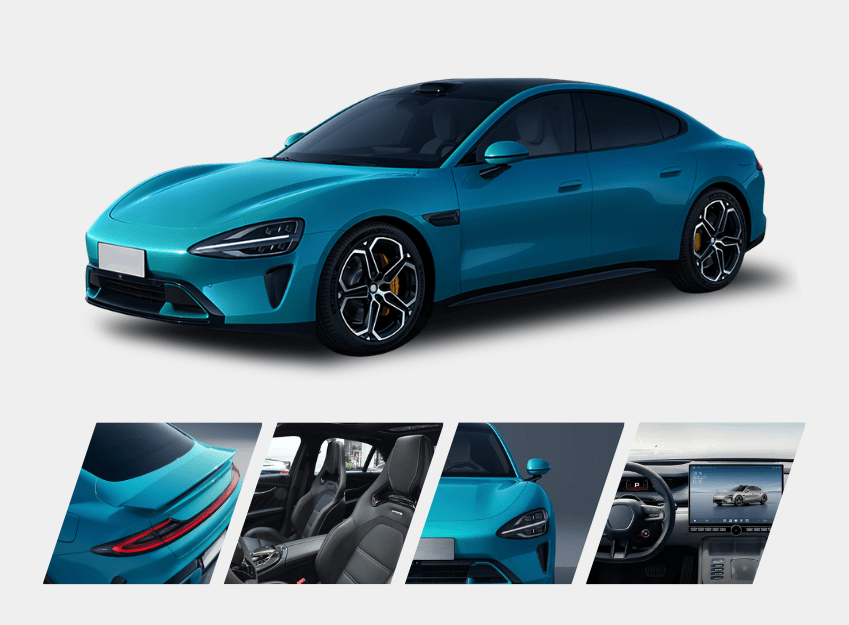
Car product photography is a category of gigantic e-commerce product photography. It is the process of photographing high-quality pictures of a car from different angles (static, dynamic, interior, exterior, etc.) with commercial purposes, highlighting the features and specialties of a vehicle so that the images are used for advertising, marketing, and sales-related promotional activities.
When a car is photographed commercially, it:
- Displays car design, curves, features, etc. So that potential buyers can understand the item.
- Exhibits differences to make viewers understand why this is a worthy choice.
- Drives purchasing desire. Thus, good images help the viewers become buyers and enhance the photographers’ skills to get more clients.
What are the Different Types of Car Photography?
The automotive industry is one of the billion-dollar and demandable industries. Due to their use, purpose, and necessity, cars are photographed in various ways. Here are the top 10 types of car photography.
1. Commercial Car Photography
Commercial car photography is vast photography. No matter what type of shots are being taken to promote the car, it falls under the commercial category. In general, taking shots of the car in a captivating way showcasing the features, internal and external parts, and gears through close shots, etc.
2. Drone or Aerial Car Photography
This type of shot is taken by using a drone or putting the camera high up to the car. When the camera view is at the top, the car is below; this perspective captures the outer side of the car from every angle.
3. Lifestyle Car Photography
Lifestyle car photography is using the car in an actual scenario, where it is generally used. That means you can take shots while the car is on the highway or in the garage. This is where models are needed to accentuate the life photos. They can drive open the car door or look out through the window to make the product look lively.
4. Concept Car Photography
Concept car photography is experimental car photography. The product is yet to be available for all types of audiences. So, this type of car requires a bit of a sensitive setting to take shots, such as creative setup and lighting, shooting somewhat differently, even in a natural perspective. This type of photo shows the car’s features and design to understand the potential traction.
5. Vintage Car Photography
As the name suggests, it is a photograph of classic vehicles. The prime focus of this type of photography is to cater to and nurture the history, design, and session of the timeless beauty of vintage cars so that they look lively and evoke sensitivity.
6. Sports Car Photography
Sports car photography shows a car’s agility, performance, design, speed, etc. This type of photo aims to advertise cars to its target audience. You can shoot it on a plain background, studio, race tracks, or highway to show the subject’s essence.
7. Car Event Photography
Event photography is dynamic and always exciting, as it is like viewing a full story of what happened in an event. The same goes for sports event photography. These photos include numerous enthusiastic people, different types of cars, and sellers.
8. Studio Car Photography
It is simply taking pictures of cars inside a studio. Studio setup has more flexibility and is equipped with many tools, like the right lighting, still background, and freedom of creativity, so the car can be shot from a wide range of angles, allowing a 360-degree view.
9. Car Photography in Action
The purpose of car action photography is to show cars’ dynamism and thrilling feeling. Action car photos are shown on the road while driving; the car splashes the water, kicking dust, etc.
10. Auto parts photography
Car auto parts are always required items, and the demand will always stay high. So, auto part photography has gained traction of its own. Through your photography, you can show different parts to make the viewers understand its build, functionality, ease of use, etc.
17 Tips for Professional Car Product Photography
A good photograph can open the door to new perspectives, evoke thought, and make viewers wonder about the photographer’s idea.
To help you make some wonderful images, aid you in taking better shots of the automotive, and upgrade your skills to the next level, check these 17 tips below:
Tip 1: Find The Perfect Location for Car Photography
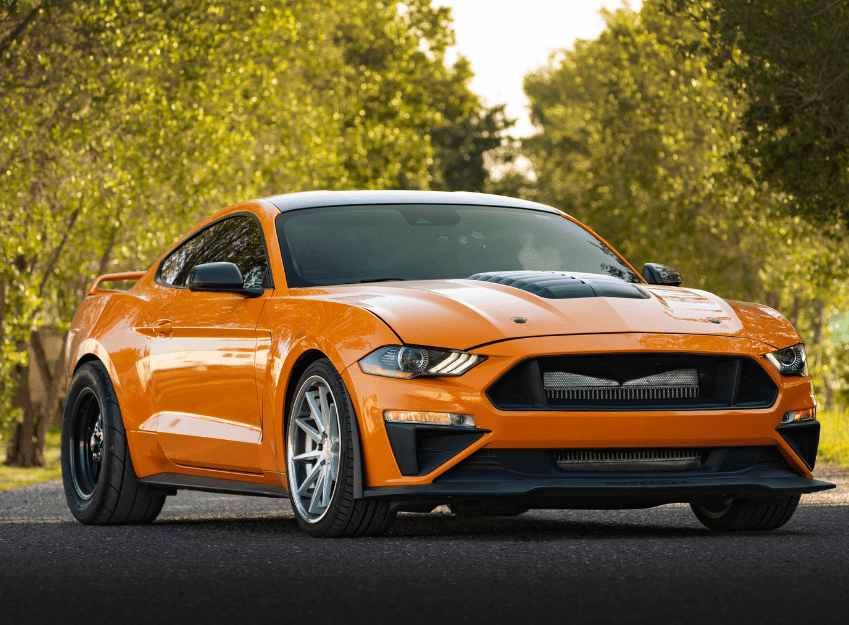
Car is a gigantic commercial product. So, the shooting spot requires a bit more consideration on different levels to take the perfect shots. It would help if you took note of:
- Photography location. If you are shooting outside, have negative space in your car photos.
- Type of car. Based on that, you can decide on the location. For example, a sports car will look better on the racetrack or airway road, whereas a jeep will suit landscapes with mountains.
- Car shape & design. Car design and shape also affect the photography. Aim to take shots where the car is seen at eye level regardless of its shape. If the car has a bulky design, consider having a simple or plain background and vice versa.
- Color of the car. The most common cars color match on every background. It is also challenging to put unique colors on the perfect background.
Tip 2: Choosing The Right Photography Gear and Equipment
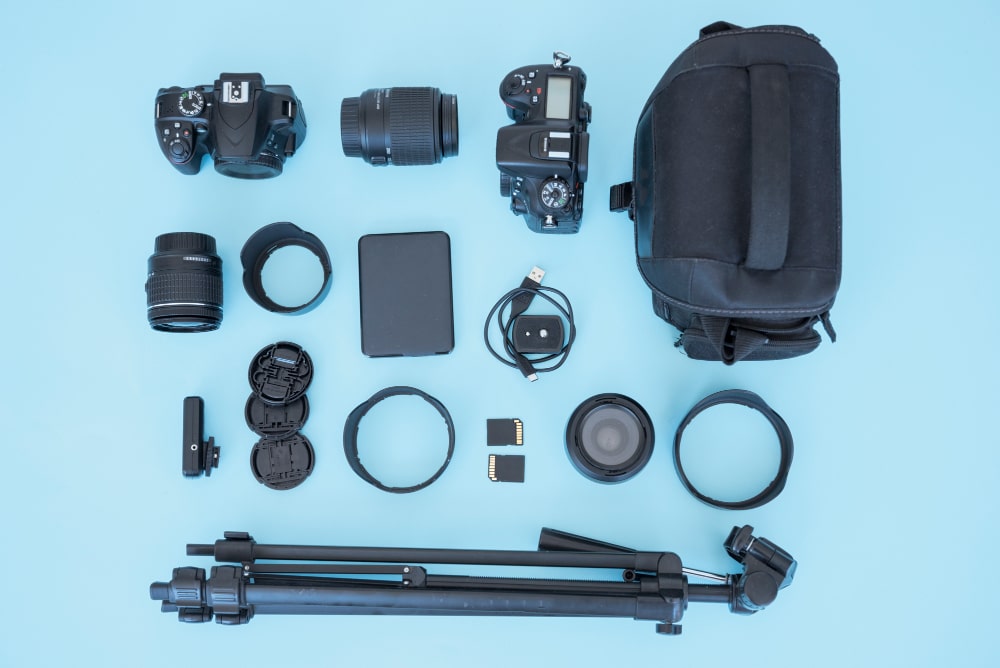
The equipment for shooting car pictures is more or less similar to any other product photography. However, if you are to carry them on location, here are the gears that you must carry.
- Tripod. Taking handheld shorts may not always be possible, considering the product is a big one. Also, it would help if you kept the camera in a steady position.
- Camera. The best type of camera for car photography depends mostly on the user’s purpose. Learning to cope with the camera functionalities will take some time. So, when choosing your camera, make sure it includes the following factors.
a) Wide dynamic range for editing flexibility.
b) High resolution and high ISO performance.
c) Fast autofocusing & high burst rate to capture motion.
d) Image Stabilization to avoid blur.
e) Weather sealing in case of adversity.
Some of my recommendations for the best camera for car photography are Canon EOS 5D Mark IV, Fujifilm FGX 100S, Nikon D850, etc.
- Lens. According to my research, these 3 types of lenses are best for car photography. Those are:
a) Wide-angle lens (14mm to 35mm): Allows you to shoot the whole surroundings and the entire length of the car.
b) A prime lens (35mm): Good for shooting close-up shots, steady photos, and fine details of automotive.
c) Medium telephoto lens (135mm+): A telephoto lens with a wide aperture makes the car appear flattering.
- Extra batteries. It is safe to take extra batteries for day-long shoots to avoid any unwanted situations.
- Memory cards. Having extra memory cards in your backpack is a smart idea, as you can transfer the captured files.
- Lens filters. You can creatively manipulate some shots into amazing outcomes with lens filters, making your car photos look astounding.
- Self-care items. You should also take things to care for yourself, such as first aid kits, food, and water.
Tip 3: Mach Camera Settings for Every Situation
Whenever you are taking photos of a car, pay heed to the time and weather and adjust your camera settings accordingly. Let me describe these through some examples.
Scenario 1: The car is in motion, and you need to take static action photos. Increase your shutter speed to around 1/2000 or more if needed. Faster shutter speed freezes motion.
Scenario 2: If you are shooting in a low light situation, increase the ISO. A high ISO number captures more light, and the photos turn out bright.
Scenario 3: You need to adjust to a wide aperture (for low light) or small aperture as per necessity. A large aperture blurs the background, making the car obvious; conversely, a small aperture sharpens the whole scene.
Tip 4: Choose The Perfect Presentation Background
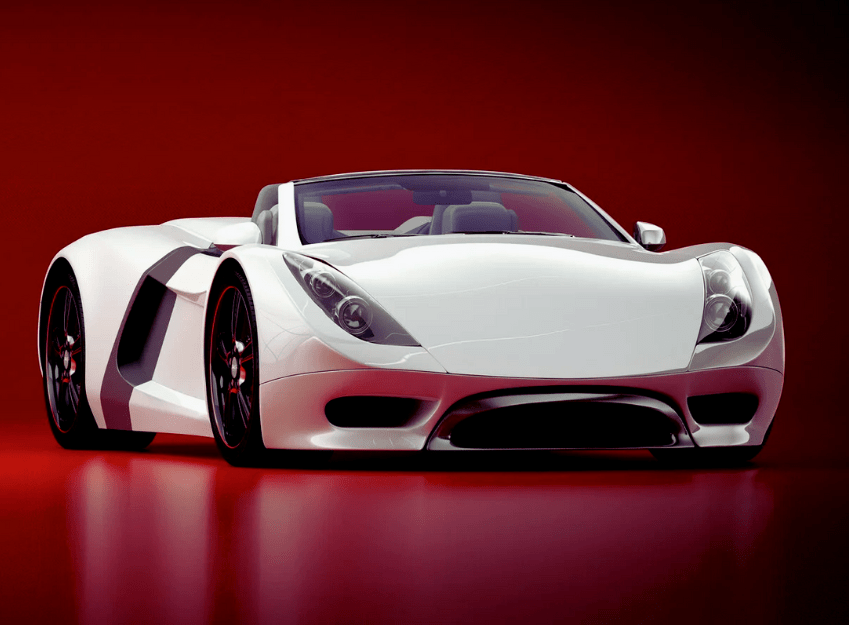
The best background for a car depends mostly on ‘3 rights’: right time, right light, and right place. If you are shooting daylight, take advantage of the light during golden hour and when the rays are still soft. If you are to shoot at nighttime, use artificial lighting sources.
Depending on the car, you can think of the background. For example, a vintage car will go well with the background of street or urban forest surroundings. You can also choose architectural, airway, or desolate areas to add curiosity or story to your frame.
Tip 5: Transmitting The Brand Identity
Put the car’s brand identity in the frame so the viewers can spot it instantly. Ensure it has no barrier that makes the logo hidden or blurred.
Though car manufacturers have shape guidelines for recognizable cars, you still need to make it obvious. It will also help you add value to your photography portfolio while working with a brand.
Tip 6: Shooting Exterior Shots During Car Photography
As the car isn’t a human to pose right, you must play around with your camera to find the best looks. Take exterior car shots from all angles.
Shoot straight on eye level, take side shots, 45-degree angles, from low and high positions. Also, take an in-depth look at headlights, logos, arrow bits, mirrors, car trunks, etc., by taking close shots, cropped shots, etc.
Tip 7: Capturing Automotive Interiors
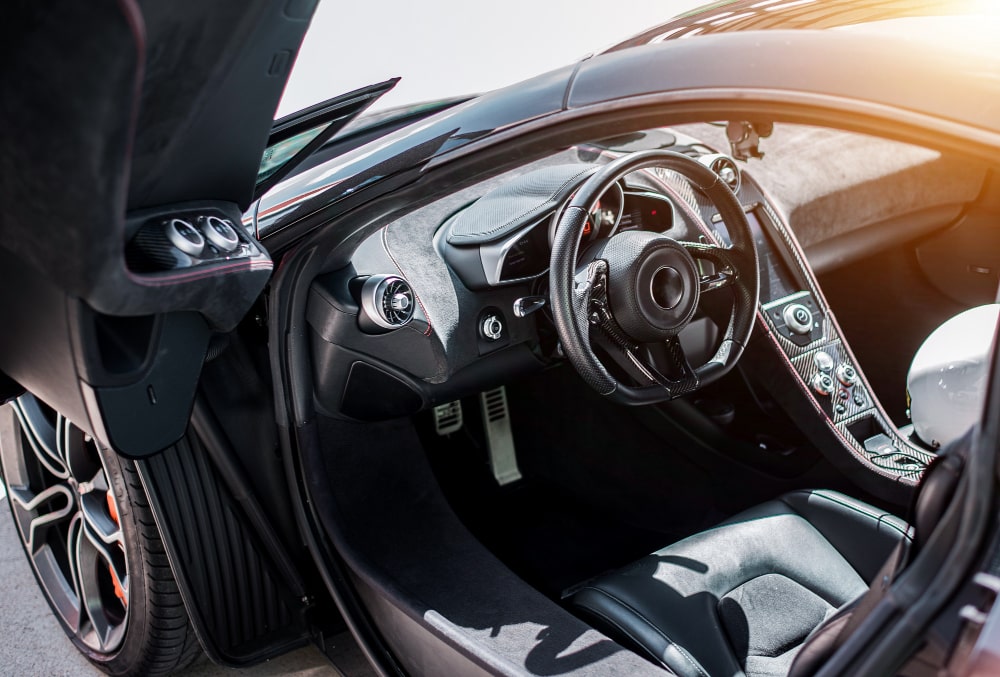
Take photos of the car interiors as part of the attention to detail. While taking shots of it, you may need external light sources. Also, opening the car windows and doors will illuminate the inside of the car. As the car is static, carry on with slow shutter speed.
Tip 8: Capture The Car from a Variety of Angles
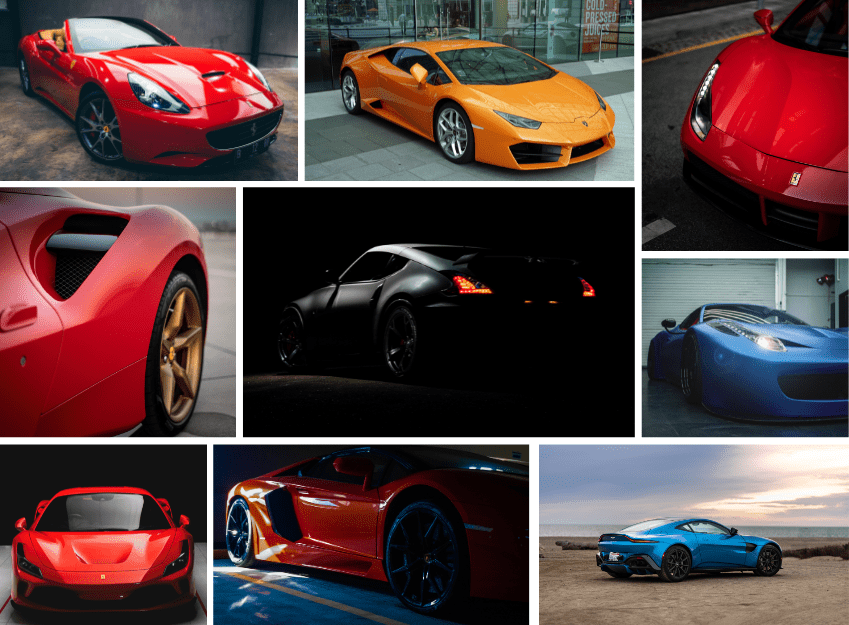
You never know which of your photos is going to go viral. So, take all the shots you can for your subject. Though every type of shot won’t be right for a car, here are a few shots you can take.
| Long/ wide shots | Taking shots of the entire car and the surroundings inside the frame. |
| Close-up shots | Blocking everything out, focusing only on the subject as it occupies most of the frame. |
| High-angle shots | Raise your camera higher than the eye level so that the view is like a person has tilted his/her head to the down position. |
| Side view shots | Take the shots from different sides of the car. |
| Eye-level shots | Capturing view on a natural view level. |
| Drone or Ariel shots | Taking shots from the top of the car. |
| Action/ motion shots | Take a picture of the car while it is in motion. |
Tip 9: Shooting Golden Hour for Magical Photos
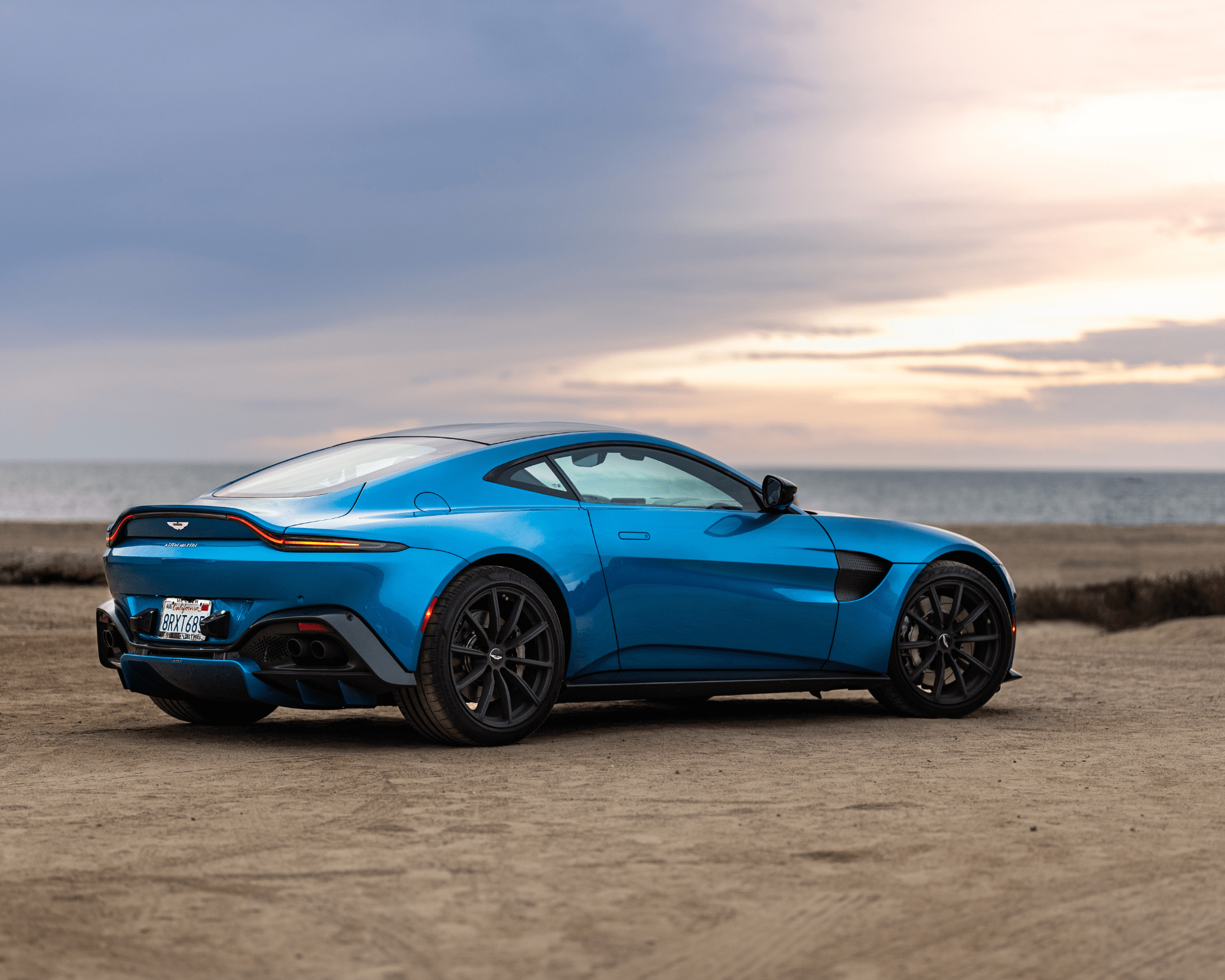
Let me remind you of some basics for taking commercial product photography.
- When to take photos? The best time is the golden hour, the first hour after sunrise, and the last hour before sunset.
- When not to take photos? When the sunlight is extremely bright and harsh, it doesn’t create good photos.
When the sunlight is soft, you can capture some amazing shots. At the other time, your captured images will get glare, shadows, color distortion, etc.
Tip 10: Understanding Your Camera’s Focal Points
When you have put the elements on your camera frame, you will see the camera focus point, which is shown as a square in the viewfinder. You can choose the focus point either manually or through autofocus. Choosing autofocus works on motion pictures. However, working with manual focus ensures accuracy.
Tip 11: Capture Driving Shot
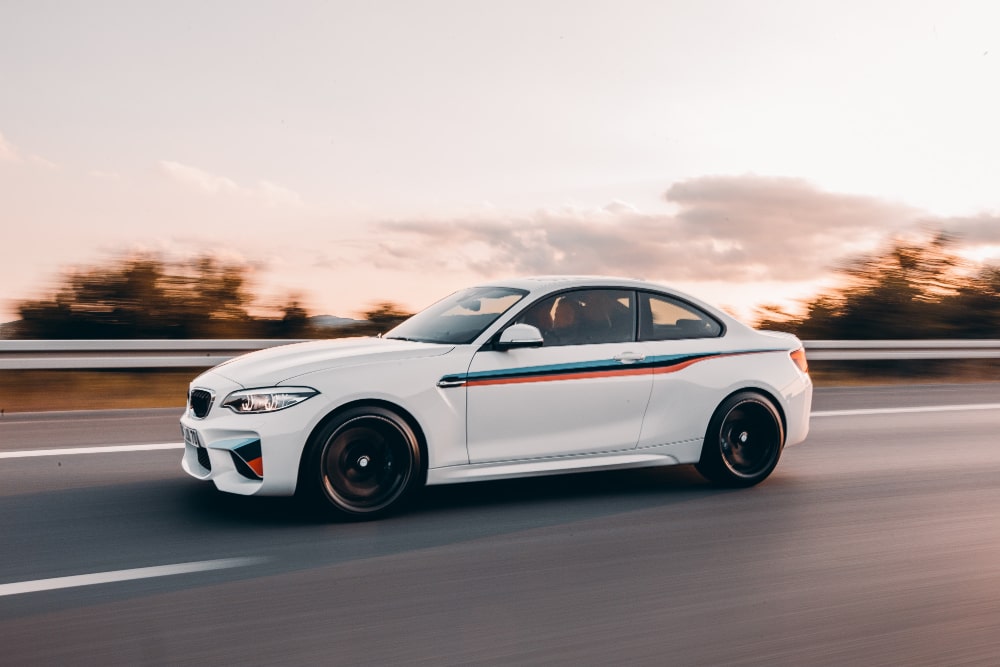
You can take motion pictures or driving shots, stay still, or shoot from another car. Adjust your camera to a fast shutter speed and high ISO. If you are shooting from a car, secure your camera in a static position. Also, choose a road that isn’t busy or shoot in the hour with less traffic.
Tip 12: Interacting with Nature
One of the main themes for outdoor car shots is collaboration with nature. Consider it as a person with a mood or vibe of tranquillity if the weather is calm, bright if the sunlight is slightly up (not harsh), or gloomy when there is a cloudy sky.
Try to merge the car with nature or the scenic view as it is. When considering those, you will naturally find out the setting (light, color, color, compositions) required to express your car best ends with nature best.
Tip 13: Taking 360 Pictures of a Car
360 e-commerce automotive photography has been on the rise for quite some time. Car products are shown in 360 views to fulfill the purpose of comprehensive details, like other products. This means that you have to take photos in a way that shows the full car when those photos are adjusted.
If you want to do this, take shots of the subject from every perspective— front, back, left, right, inside, outside, etc. Then, edit those pictures together to make one.
Tip 14: Photographing Car Portraits at Night
To make some lucrative shots like trail photos, take shots at night. You will get some phenomenal and creative photos of your car. The location for night car photos can be anywhere. However, I suggest choosing a less chaotic area.
The camera settings for night car photography should be wide aperture, high ISO, and long shutter speed.
Tip 15: Elevate Your Car Photography with Models
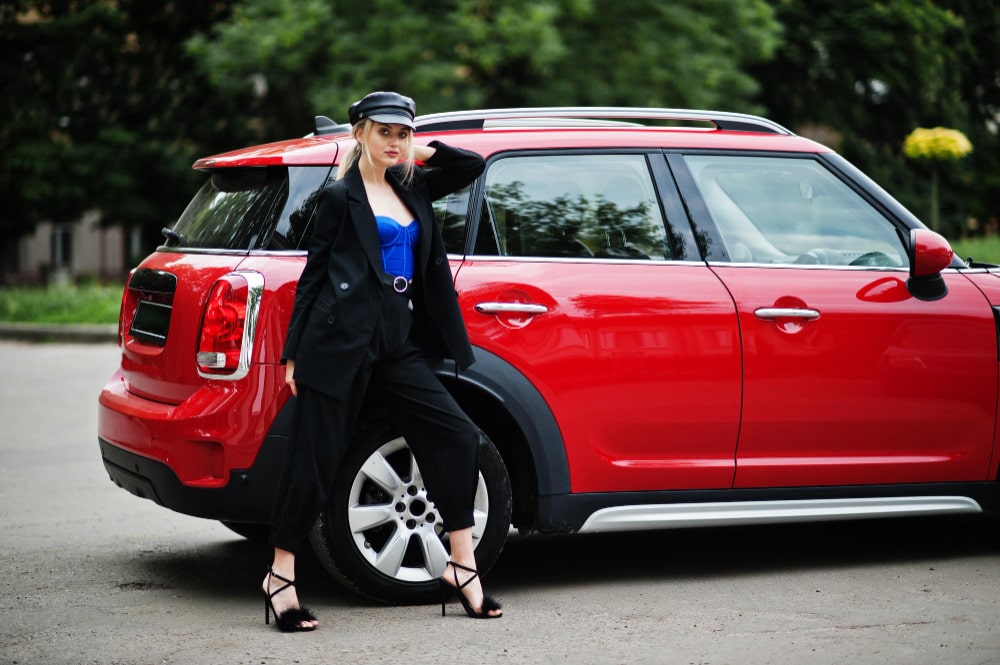
Want to add dynamism and realism to your car photos? Engage models. Car photography model poses and photoshoot concepts bring out amazing output. This type of photo works well for highlighting any specific features of the cars as well.
Tip 16: Assure The Pristine Condition of The car
Cross-check the cleanliness and newness of the car before capturing photos. Ensure there aren’t any scratch marks, dents, dirt, etc. You have to have a clear-washed car. You don’t want viewers to think negatively about the photos, the car, or the photographer’s negligence.
However, if some issues can’t be sorted out, you have 2 options.
- Change your position right on the opposite side.
- Edit your photos afterward.
Even so, staying alert at first will save you from many troubles.
Tip 17: Automobile Photography Post-Production
Last but not least, take advantage of magical photography post-production works.
Car photography post-production elevates the look of your digital images by reducing image issues of colors, shadows, reflections, removing unwanted objects, etc. Also, by adjusting colors, you can bring out lucrative, luxurious looks that aren’t generally possible to capture through the camera.
Hire The Best Photo Editing Company
You can always count on professional photography post-production services if the work seems to be a hassle. You will get a premium quality finalized version of your car photos.
FAQs about Car Product Photography
What is the best position for car photography?
The best position for car photography worldwide is to capture car photos straight at eye level. Some other car photography angles are 45-degree angle views, side views, drone views, etc.
What aperture is best for car photography?
A wide aperture is a good fit for car photography as it blurs the surroundings, making the car stand out. Keep your aperture around f/4. If you want to take both the background and the foreground, then f/8 is a good option to start.
What is the best focal length for car photography?
The best focal length for car photography is 35mm. As this is a prime lens, you can view the car from a comfortable distance.
What is the best lens for car photography?
The best lenses for car photography are a wide-angle lens, a prime lens, and a medium telephoto lens.
Conclusion
There you have it. 17 car photography tips to bring out amazing photos.
Car photography is not about getting on one go type. You have to take a variety of photos to understand which scene your camera is capturing the best and what your style is for figuring out the best shots.
As long as you are trying, you will improve, and I hope these tips will help you with your experiments. Keep an eye on our blog for more helpful photography articles. See you soon!
